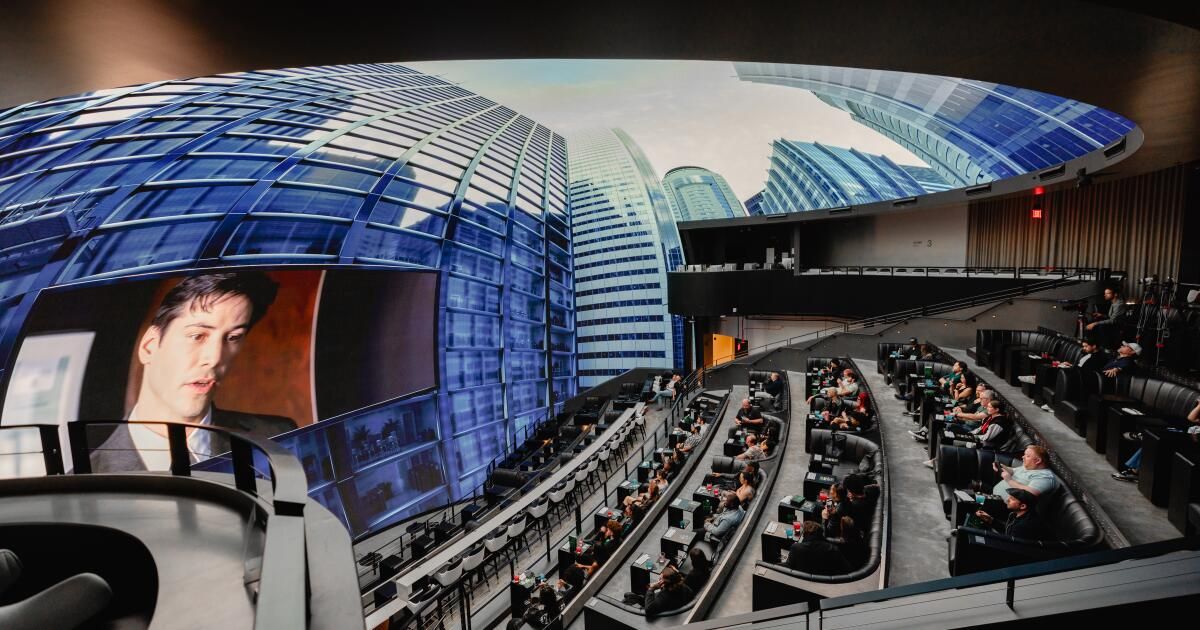When you watch “The Matrix” in Cosm, you are essentially watching a movie inside a movie. A shot inside an apartment becomes a look at a whole complex. A fighting fighting scene is now a small part of a giant urban landscape. Look to the left, and a helicopter once off the screen is suddenly visible.
Cosm has earned attention and a fan base for its focus on sports programming. An 87 -foot diameter married wrapping screen surrounds the public at the Inglewood place, creating an illusion of presence in the Flesh. Can't you get to that game from the NBA finals or the World Series? Cosm wants to be its support plan, combining front row seats with unexpected views.
And now, Cosm aims to redefine the film experience. A “The Matrix” rebirth opens Thursday in what the company calls “shared reality”, a marketing term that finally means newly created CGI animation towers, about the original film of 1999 in 1999. Cosm has shown in the past an original programming to a large extent shortly, and “The Matrix” marks its first incursion into long -term films.
Carrie-Anne Moss and Keanu Reeves in “The Matrix”, which opens in Cosm with newly created CGIs surrounding the original frame.
(Cosm)
Hope is not only to watch the film with fresh eyes, but to create a feeling of being in the same environment as Keanu Reeves's neo, the Trinity of Carrie-Anne Moss and Morpheus de Laurence Fishburne. “The Matrix” is an ideal film for this experiment, its decidedly topical anti-Ai message, while their songs deal with double visions of reality.
There has been a number of the so-called immersive ambitions to alter the film experience throughout the decades, be it the interactive flirting with interactive cinema, a brief trend in the 90s that recently lived again on Netflix (see “Black Mirror: Bandersnatch”), to the most recent 4-Dx teetors with sedathers with secomos “Twisters”). Cosm, like the largest sphere and focused on live music in Las Vegas, seems to have a different launch: a screen that covers everything that can provide previously unexplored views, even sometimes creating a sense of movement similar to a theme park.
The interpretation of COSM of “The Matrix”, a collaboration with the experimental creative agency Little Cinema, involves the public of its opening action sequence when a night view of a city horizon apparently places us on a roof. On the other hand, the Neo office building becomes a maze of cubicles. The centerpiece of the film of the film versus the moment of the blue pill focuses the frame between the bright and large capsules. When Neo wakes up, we are lost in the midst of mountainous industrial pods.
The challenge: do not make you feel like a trick, even knowing when to back down and let the film defend itself. “The central principle number 1 was to improve and not eclipse,” says Jay Rinsky, founder of Little Cinema. “Metaphorically for us, the film itself is the main singer and we are the backup band. Let the film be the star. Let it sing. And basically follow the key rhythms: follow the sound design, emotional moments and improve action.”

The Red Pill scene versus Azul in “The Matrix” is framed with a recently created animation.
(Cosm)
The accompanying images become more aggressive as the film runs towards its climax. The animations are more effective when they are expanding the screen instead of echoing the action, showing us the point of view of a beareling helicopter, for example, instead of repeating or imitating a rhythm of the film. Having seen “The Matrix” before, I know the story and its cadence, and perhaps I was more willing to remove my attention from the film, which is placed in the center of the screen is often placed within an image frame.
In turn, it dazzled by the scenes filmed inside the Morpheus Aerohalte, the Nebuchadnezzar, in which the surroundings of the ship, its buzz, electric nucleus and its variety of monitors, develop around the screen. Movie purists, I wonder, can worry about seeing images beyond the director's vision, Rinsky says he has not been in contact with Lana or Lilly Wachowski directors, but I discovered that I could help build a world, especially for Renaissance cinema in a second or third vision.

A “The Matrix” scene starring Carrie-Anne Moss is surrounded by a general view of a horizon.
(Cosm)
As expected, the final act of the film becomes a secondary action group. The bullets that fly from the film frame now find a place of landing, while the walls of the building break and fall apart around us. The Cosm screen is clear and covers enough so that the movement or flight can imitate, and fortunately this is used in moderation, twisting only when the characters in the film face the heavens.
When Cosm opened last summer, executive president Jeb Terry stressed, the place was not in the business of showing films, wanting to concentrate on sports or original programming. “We are not a first race theater,” Terry said. “We are leaning on the experimental side.” Apparently, “The Matrix” fits this plan, since the CGI images that accompany it have been in process since August 2024, says Rinsky, with most of the heavy work as of January.
Rinsky acknowledges that “The Matrix” conforms to the format particularly well because “plays in a field of fantasy that allows him to change environments”, but he rushes to add that Cosm and Little Cinema hope to expand the program to improve Hollywood products. “It is a bit a mission and a philosophy,” he says. “Each film in each genre has its own unique propositions and can be adopted and adequate well. We are excited about horror and we are excited about comedy.” Future projects have not yet been announced.
Cosm also has a place in Dallas, with places in Atlanta and Detroit on the way. Rinsky's hope, of course, is that Cosm one day has enough market penetration that filmmakers can create the format from scratch.
“I am really optimistic that this is the new cinema,” says Rinsky. “I think in five to 10 years, there will be 100 of these. Once it reaches the scale, the great studies will have launches specifically created for this format.”
It is an optimistic vision of the future that arrives at a time of interruption in Hollywood, from shaking due to the transmission market to artificial intelligence. For Cosm, they are the first days, but it is a vision that does not need a red or blue pill. Your perspective is much more pink.












